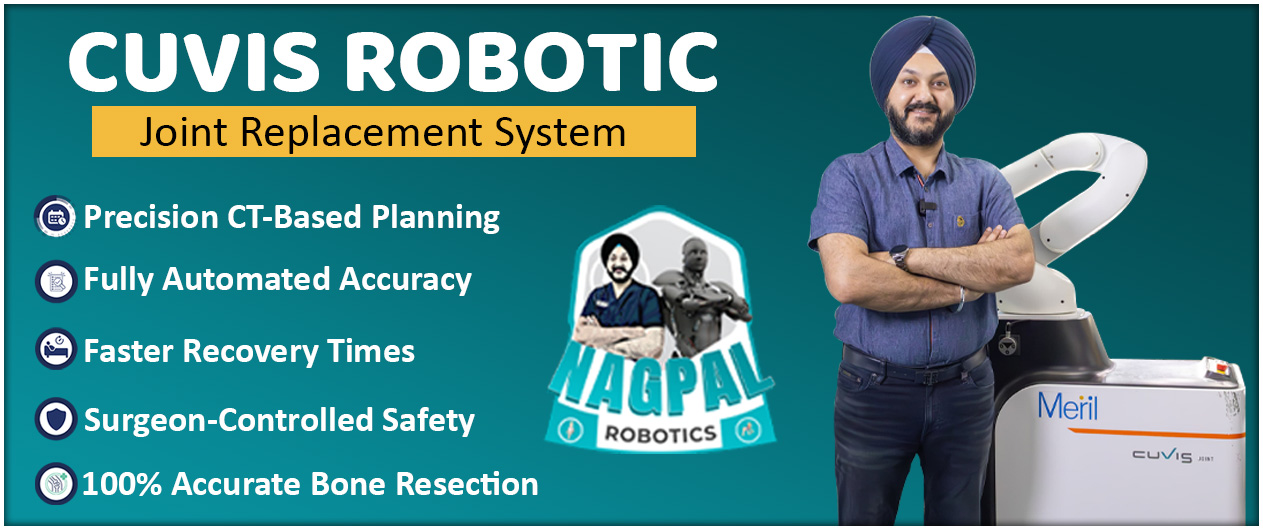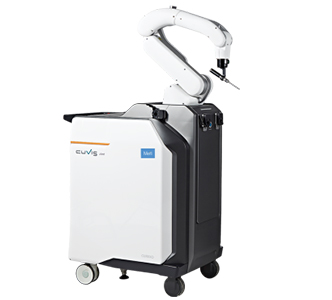-
 +91 98551-63355
+91 98551-63355 - nagpaljointclinic@gmail.com
 +91 98551-63355
+91 98551-63355





Knee joint replacement is a procedure that involves replacing an injured or ailing knee with an artificial joint, or prosthesis. During the procedure, which lasts between one and two hours, your surgeon will make a long surgical cut above your knee. With the skin and muscle pulled back, they’ll cut away damaged cartilage and bone. They’ll affix the new knee joint to your femur, or thighbone, and tibia, which is the main bone in your lower leg. They’ll do this using specialized cement, pins, and screws. Afterward, your surgeon will close the incision wound with stitches and apply a bandage.
With the increasing cases of Arthritis, Rheumatoid, and Osteoarthritis, knee pain leading to knee replacement surgeries is at a rise. In a scenario like this, a breakthrough technology is an all-time boon that can help surgeons perform the surgery without the scope of manual or miscalculated error and help patients get the best of outcomes. To address the requirements of both patients and surgeons, CUVIS Robot, Punjab’s first fully active robot for knee replacement surgery is here at Nagpal Superspeciality Hospital, Bathinda.
Cuvis Joint Robot System is the most advanced surgical cutting edge robotic technology supporting surgeons with Personalized Preplanning and Precise Cutting for predictable and consistent results. It is made up of three key components: the Main Console, the Robotic Arm, and the Planning Device. The Main Console with Optical Tracking System (OTS) aids in real-time monitoring and directs the surgeon through the procedure. The majority of the bone cutting is done by a robotic arm with a milling tool positioned on its tip.

The CUVIS Joint Robot creates a 3D model of the patient's knee, which the surgeon utilizes as a guide to make correct bone incisions and precisely place the knee components.
Personalized pre-planning: The doctor uses 3D pictures of the patient's joints to arrange the operation specifically for each patient.
Pre-selection and exact insertion of artificial joint: The doctor utilizes the robot to choose and precisely install an artificial joint for the patient.
Precise cutting for accuracy and optimum alignment: The robot analyses the data and accurately slices the bone in relation to the dimensions of the pre-selected implant.






CUVIS JOINT is completely independent, whereas the other robots work as a helping hand. The robotic technologies present at the moment can be categorized as passive or semi-active devices but CUVIS Joint is a fully active robot. The others does have a robotic arm but is passive, the surgeon holds the same and performs the cutting of bone area.
Nagpal Superspeciality Hospital has always strived to serve patients with superior care supported by up-to-the-minute technology. CUVIS Joint Robot System is a step towards our mission. With this next level of technology, we seek to empower our surgeons and benefit our patients at the same time. In turn, bringing the change in the face of joint replacement surgeries. Make an appointment to learn more.
◐ Up to 20% of patients remaining dissatisfied following TKA.
◐ Human controlled variables affecting outcome in TKA
◐ Conventional jig-based TKA uses preoperative radiographic films, intra-operative anatomical landmarks, and manually positioned alignment jigs to guide bone resection and implant positioning.
◐ Conventional jig-based TKA is associated with poor reproducibility of alignment-guide positioning, inadvertent saw blade injury to the periarticular soft-tissue envelope, and limited intra-operative data on gap measurements or ligamentous tensioning to fine tune the implant positioning.
◐ Suboptimal implant positioning may lead to
◐ In navigated TKR, computer software converts anatomical information obtained from intra-operative osseous mapping into a virtual patient-specific 3D model of the knee joint.
◐ Virtual model is used to plan optimal bone resection, implant positioning, bone coverage, and limb alignment based on the patient’s unique anatomy.
◐ Computer navigated TKA provides patient-specific anatomical data with recommendations for bone resection and optimal component positioning.
In robotic TKR, a robotic device helps to execute this preoperative patient-specific plan with a high level of accuracy.
◐ Robotic TKR uses optical motion capture technology to assess intra-operative alignment, component positioning, range of movement, flexion-extension gaps, and soft tissue balancing.
◐ RTKR actively controls and/or restrains/eliminate the surgeon’s motor function to improve the accuracy of achieving the planned bone resection and implant positioning.
◐ Real-time intra-operative data can then be used to fine-tune bone resection and guide implant positioning, in order to achieve the desired knee kinematics and limit the need for additional soft tissue releases.
◐ RTKR associated with improved accuracy of achieving the planned femoral and tibial implant positioning, joint line restoration, limb alignment, and posterior tibial slope compared with conventional jig-based TKA.
◐ Results in improved accuracy in implant positioning in all three planes and reduces outliers.
Powered by Nagpal Robotics @2025
Created With ❤️ By Digital Dots